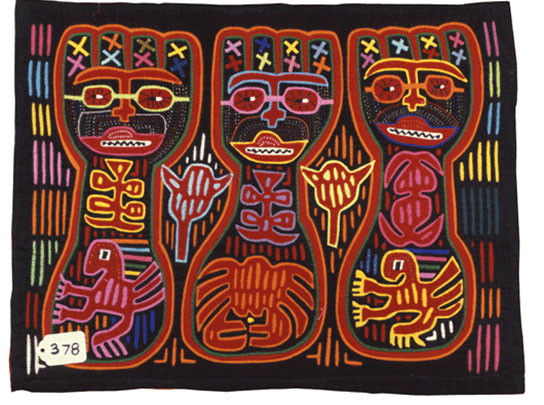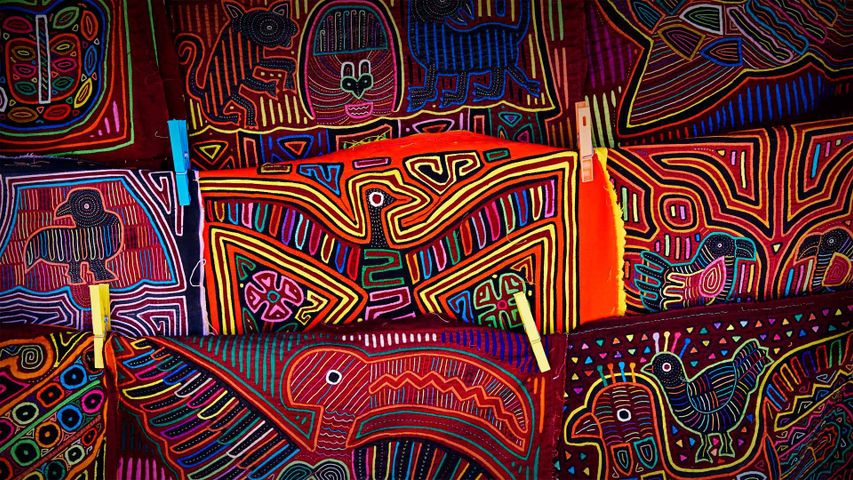
Threads of Identity: The Enduring Artistry of Panama’s Guna Mola
In the emerald embrace of Panama’s Caribbean coast, across the scattered islands and mainland territories of the Comarca Guna Yala, a vibrant, intricate art form flourishes, telling stories as old as the wind and as fresh as the morning dew. This is the Mola, the iconic textile art of the Guna (formerly Kuna) people, a masterpiece of reverse appliqué that transcends mere craft to embody the very soul, history, and future of an extraordinary indigenous culture. Far from a simple souvenir, the Mola is a living canvas, a protective charm, a political statement, and an unwavering declaration of Guna identity.
The word "Mola" itself means "clothing" or "blouse" in the Guna language, referring to the intricately sewn panels that form the front and back of the Guna woman’s traditional blouse. But to call it merely clothing is to dramatically underestimate its profound significance. Each Mola is a testament to the Guna women’s unparalleled skill, patience, and profound connection to their ancestral cosmology and daily life.
The Art of Reverse Appliqué: A Dazzling Complexity
At its core, Mola art is a sophisticated form of reverse appliqué. Unlike traditional appliqué where shapes are sewn onto a base fabric, Guna artisans begin with several layers of different colored cloth, typically two to seven, meticulously stacked one upon another. The design is then carefully cut into the top layer, revealing the color beneath. These edges are then painstakingly turned under and hand-stitched with tiny, almost invisible stitches. Subsequent layers are cut and sewn in the same manner, building up a mesmerizing, multi-dimensional pattern.
The process is slow and demanding. A single, complex Mola panel, measuring approximately 10×15 inches, can take weeks, or even months, to complete, depending on the intricacy of the design and the number of layers involved. The precision required is astounding; lines must be perfectly even, curves smooth, and the stitches uniform, all executed freehand without the aid of stencils or patterns. This ensures that each Mola is a unique creation, reflecting the individual vision and skill of its maker. The vibrant palette – a dazzling kaleidoscope of crimson, cerulean, emerald, gold, black, and white – is not arbitrary but often chosen for its symbolic resonance, mirroring the vivid colors of the Guna’s natural environment: the coral reefs, the tropical birds, the lush rainforest.

Beyond Aesthetics: Mola as Cultural Narrative and Protection
To the Guna, a Mola is far more than a decorative item. It is a visual language, a repository of knowledge, and a tangible link to their spiritual world. Historically, Guna women adorned their bodies with geometric designs before the arrival of textiles, a practice known as wayas. When missionaries introduced cloth, the Guna adapted their body art onto fabric, transforming it into the Mola we know today. This transition marked a pivotal moment, allowing the intricate designs to become portable, durable, and shareable.
The designs themselves are deeply symbolic, drawn from a rich tapestry of sources:
- Cosmology and Spirituality: Many Molas depict scenes from Guna mythology, ancient legends, and spiritual beliefs. Geometric patterns often represent the universe, the path of the sun, or the various levels of the Guna cosmos. Some designs are believed to offer protection from evil spirits, mirroring the function of nuchus, small wooden figures used for spiritual healing and safeguarding.
- Nature: The abundant flora and fauna of the Guna Yala islands and mainland are frequent motifs. Jaguars, monkeys, birds (especially the harpy eagle, a sacred animal), fish, turtles, and various plants are rendered with a distinctive Guna aesthetic, often abstracted and stylized.
- Daily Life: Scenes from Guna village life, fishing, ceremonies, and communal activities provide a window into their world.
- Political and Social Commentary: In a striking demonstration of its adaptability, the Mola has also served as a powerful medium for political expression. Throughout the 20th century, Molas were created to protest against foreign interventions, advocate for Guna autonomy, or commemorate significant historical events, such as the 1925 Guna Revolution against Panamanian authorities. These "political Molas" are rare and highly prized, offering a unique historical record.

As one Guna elder, Manuela Pérez, wisely stated, "Our Mola is our history, our dreams, our protection. When we sew, we are speaking the language of our ancestors." This sentiment underscores the profound connection between the Guna people and their textile art, where each stitch reinforces cultural identity and spiritual well-being.
The Guna Woman: Guardian of a Living Tradition
The creation of Molas is almost exclusively the domain of Guna women, who learn the art from a young age, typically from their mothers and grandmothers. This intergenerational transfer of knowledge is crucial for the preservation of the tradition. Girls watch, then practice, slowly mastering the intricate techniques and absorbing the symbolic language embedded within the designs. The Mola is thus intrinsically linked to Guna womanhood, acting as a powerful symbol of their creativity, economic independence, and role as cultural custodians.
Guna women typically wear two Mola panels, one on the front and one on the back of their traditional blouses, known as dulemor. These blouses, paired with patterned wraparound skirts (saburet), headscarves (muswe), and intricate beadwork arm and leg bands (wini), form a distinctive and instantly recognizable traditional attire. The Molas on a woman’s blouse are not just fashion statements; they are a public declaration of her identity, her artistic prowess, and her connection to her community’s heritage.
Economic Sustenance and Global Recognition
In addition to its cultural and spiritual value, Mola art plays a significant economic role for the Guna people. The sale of Molas, both as individual panels and incorporated into various textile products, provides a crucial source of income for many Guna families. This income often empowers women, allowing them to support their households and maintain their traditional way of life in the face of modern economic pressures.
The global art market has increasingly recognized the artistic merit of Molas. They are collected by museums, galleries, and private enthusiasts worldwide, lauded for their intricate designs, vibrant colors, and unique artistic technique. This international appreciation has brought both opportunities and challenges.
Challenges in a Changing World: Authenticity and Appropriation
The growing demand for Molas has, inevitably, led to certain pressures. The need for income can sometimes lead to a focus on speed over intricate detail, or the creation of simpler, more repetitive designs for the tourist market. There is also the persistent threat of cultural appropriation, where non-Guna artists or companies reproduce Mola-like designs without proper attribution or compensation to the Guna people, diluting the authenticity and economic value of the original art.
The Guna themselves are acutely aware of these challenges. Efforts are being made within the Comarca to protect their intellectual property rights and ensure that the benefits of Mola sales directly support the Guna communities. Organizations and cooperatives are working to promote fair trade practices, educate buyers about the cultural significance of Molas, and empower Guna artisans to maintain the high standards of their tradition.
The Future of Mola: Adapting While Preserving
Despite the pressures of modernity, the Mola tradition shows remarkable resilience and adaptability. Younger generations of Guna women are finding new ways to express themselves through Mola art, incorporating contemporary themes or experimenting with new forms while still honoring the fundamental techniques and symbolism. Molas are appearing in new contexts – as wall hangings, framed art, or incorporated into modern fashion items – reaching wider audiences without necessarily compromising their core essence.
The Guna Mola is more than just a textile; it is a living, breathing testament to the enduring spirit of an indigenous people. It is a vibrant thread woven into the fabric of their identity, a silent storyteller of their history, and a bold declaration of their cultural sovereignty. As long as Guna women continue to cut, layer, and stitch, the Molas will continue to speak, sharing the beauty, wisdom, and resilience of a unique Panamanian treasure with the world. In every intricate pattern and every vibrant hue, the spirit of the Guna people lives on, a masterpiece of art, culture, and unwavering identity.